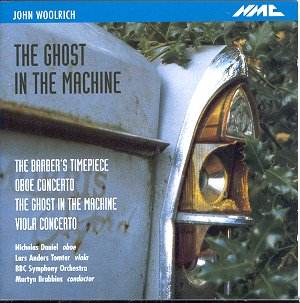 Composer: John Woolrich (born 1954)
Composer: John Woolrich (born 1954)
Works: The Barber’s Timepiece (1986), Oboe Concerto (1996), The Ghost in the Machine (1990), Viola Concerto (1993)
Performers: Nicholas Daniel (oboe), Lars Anders Tomter (viola), BBC Symphony Orchestra, Martyn Brabbins
Recorded: BBC Studio 1, Maida Vale, London, February 1999
Label: NMC D 071
Duration: 77:45
In a compelling survey of John Woolrich’s oeuvre, this release from NMC captures the essence of a composer whose voice, while steeped in tradition, is distinctly personal and innovative. Featuring a quartet of his major works, the recording offers an excellent opportunity to delve into Woolrich’s intricate musical language, marked by a deft combination of lyrical melodies and rhythmic complexities.
The earliest piece, The Barber’s Timepiece, serves as a vivid introduction to Woolrich’s style. Here, he juxtaposes a slow, chorale-like theme with an undercurrent of ticking percussion, a device that becomes a hallmark of his compositional voice. The rhythmic interruptions, particularly the brief but impactful percussive jabs, create a dialogue between the serene and the jarring. This interplay not only allows for a captivating opening but also establishes a tonal landscape that feels both familiar and unsettling. The piece culminates in a gentle decrescendo, leaving the listener in a state of suspended contemplation—an effective choice that underscores Woolrich’s penchant for ambiguity.
In contrast, The Ghost in the Machine reflects a more expansive and somewhat epic quality. Described by Woolrich as “a fifteen-minute accelerando for large orchestra,” this work unfolds a tapestry of sound that recalls the orchestral breadth of Mahler. The thematic material, introduced by the horns, recurs in a myriad of textures, showcasing Woolrich’s skill in recontextualizing motifs. The final moments, featuring a solitary trumpet—evoking the Last Post—against a backdrop of ethereal strings, resonate with a poignant stillness that lingers long after the last note has faded.
Turning to the Viola Concerto, one encounters a deeply introspective work that shifts the focus onto the soloist. Woolrich describes it as a “cycle of seven bleak and brooding songs-without-words,” and indeed, the viola’s voice emerges as the emotional core of the piece. Lars Anders Tomter’s performance is particularly noteworthy; his phrasing is imbued with an understated eloquence that elevates the work’s tender, reflective character. The orchestration, while classically structured with a limited percussion palette, allows the viola to shine, echoing its song with an array of soft, gentle colors. This work stands out not only as one of Woolrich’s most successful compositions but also as a significant addition to the viola repertoire.
The Oboe Concerto presents a striking contrast, showcasing Woolrich’s innovative spirit through an extravagant orchestration that includes an array of unconventional percussion instruments. Nicholas Daniel’s virtuosity shines through here, as he navigates the concerto’s lyrical passages with grace. The interplay between the solo oboe and the expanded orchestral forces is deftly managed, maintaining a sense of cohesion amidst the potential chaos of its instrumentation. Woolrich’s economy in orchestrating such diverse sounds is particularly effective, allowing the piece to retain a lyrical quality even amid its more dynamic sections. The thematic material, while rooted in simplicity, blossoms into a rich tapestry of sound, a testament to Woolrich’s ability to draw intricate variations from his musical ideas.
The engineering quality of this recording merits commendation; the balance between soloists and the orchestra is well-maintained, allowing for clarity of detail without sacrificing the lushness of the orchestral sound. The reverberation of the Maida Vale studios enhances the warmth of the strings and the nuanced colors of the winds, providing a fitting backdrop for Woolrich’s sonic explorations.
Historically, these works reflect a composer engaged with the lineage of Western art music while forging his unique identity within it. Woolrich’s music, with its rich intertextuality and emotional depth, deserves to be recognized as an essential part of contemporary classical music discourse. His ability to evoke a broad spectrum of emotions through simple yet profound musical materials places him squarely in the conversation alongside his predecessors and contemporaries.
In conclusion, this release not only showcases John Woolrich’s diverse compositional output but also highlights the exceptional artistry of the performers involved. With its thoughtful interpretations and high production values, it serves as an excellent introduction to Woolrich’s innovative sound world. For those who may be unfamiliar with his music, this recording offers an engaging and insightful exploration—one that promises to resonate with both seasoned listeners and newcomers alike. Warmly recommended.